2016年12月英语四级真题及答案第三套
Part I
Writing
(30 minutes)
Directions: For this part, you are allowed 30 minutes to write an essay. Suppose
you have two options upon graduation: one is to work in a state-owned
businessandtheotherinajointventure.Youaretomakeachoicebetween
thetwo.Writeanessaytoexplainthereasonsforyourchoice.Youshould
write at least 120 words but no more than 180 words.
Part Ⅱ
Listening Comprehension
(25 minutes)
Section A
Directions: In this section,you will hear three newsreports. At the endof each
newsreport,youwillheartwoorthreequestions.Boththenewsreport
and the questions will be spoken only once. After you hear a question,
youmustchoosethebestanswerfromthefourchoicesmarkedA),B),C)
andD).ThenmarkthecorrespondingletteronAnswerSheet1withasingle
line through the centre.
Questions 1 and 2 are based on the news report you have just heard.
1. A) To satisfy the curiosity of tourists.
B) To replace two old stone bridges.
C) To enable tourists to visit Goat Island.
D) To improve utility services in the state.
2. A) Countless tree limbs.
B) A few skeletons.
C) Lots of wrecked boats and ships.
D) Millions of coins on the bottom.
Questions 3 and 4 are based on the news report you have just heard.
3. A) It suspended diplomatic relations with Libya.
B) It urged tourists to leave Tunisia immediately.
�
C) It shut down two border crossings with Libya.
D) It launched a fierce attack against Islamic State.
4. A) Advise Tunisian civilians on how to take safety precautions.
B) Track down the organization responsible for the terrorist attack.
C) Train qualified security personnel for the Tunisian government.
D) Devise a monitoring system on the Tunisian border with Libya.
Questions 5 to 7 are based on the news report you have just heard.
5. A) An environment-friendly battery.
B) An energy-saving mobile phone.
C) A plant-powered mobile phone charger.
D) A device to help plants absorb sunlight.
6. A) While sitting in their schools courtyard.
B) While playing games on their phones.
C) While solving a mathematical problem.
D) While doing a chemical experiment.
7. A) It increases the applications of mobile phones.
B) It speeds up the process of photosynthesis.
C) It improves the reception of mobile phones.
D) It collects the energy released by plants.
Section B
Directions: In this section, you will hear two long conversations. At the end of
each conversation, you will hear four questions. Both the conversation
and the questions will be spoken only once. After you hear a question,
youmustchoosethebestanswerfromthefourchoicesmarkedA),B),C)
andD).ThenmarkthecorrespondingletteronAnswerSheet1withasingle
line through the centre.
Questions 8 to 11 are based on the conversation you have just heard.
8. A) He visited the workshops in the Grimsby plant.
�
B) He called the woman and left her a message.
C) He used stand-ins as replacements on all lines.
D) He asked a technician to fix the broken production line.
9. A) It is the most modern production line.
B) It assembles super-intelligent robots.
C) It has stopped working completely.
D) It is going to be upgraded soon.
10. A) To seek her permission.
B) To place an order for robots.
C) To request her to return at once.
D) To ask for Tom’s phone number.
11. A) She is on duty.
B) She is having her day off.
C) She is on sick leave.
D) She is abroad on business.
Questions 12 to 15 are based on the conversation you have just heard.
12. A) He saved a baby boy’s life.
B) He wanted to be a superhero.
C) He prevented a train crash.
D) He was a witness to an accident.
13. A) He has a 9-month-old boy.
B) He is currently unemployed.
C) He enjoys the interview.
D) He commutes by subway.
14. A) A rock on the tracks.
B) A misplaced pushchair.
C) A strong wind.
D) A speeding car.
15. A) She stood motionless in shock.
�
B) She cried bitterly.
C) She called the police at once.
D) She shouted for help.
Section C
Directions: Inthissection,youwillhearthreepassages.Attheendofeachpassage,
youwillhearthreeorfourquestions.Boththepassageandthequestions
willbespokenonlyonce.Afteryouhearaquestion,youmustchoosethe
best answer from the four choices marked A), B), C) and D). Then mark
the corresponding letter on Answer Sheet 1 with a single line through
the centre.
Questions 16 to 18 are based on the passage you have just heard.
16. A) She inherited her family ice-cream business in Billings.
B) She loved the ice-cream business more than teaching primary school.
C) She started an ice-cream business to finance her daughter’s education.
D) She wanted to have an ice-cream truck when she was a little girl.
17. A) To preserve a tradition.
B) To amuse her daughter.
C) To help local education.
D) To make some extra money.
18. A) To raise money for business expansion.
B) To make her truck attractive to children.
C) To allow poor kids to have ice-cream too.
D) To teach kids the value of mutual support.
Questions 19 to 21 are based on the passage you have just heard.
19. A) The reasons for imposing taxes.
B) The various services money can buy.
C) The various burdens on ordinary citizens.
D) The function of money in the modern world.
�
20. A) Educating and training citizens.
B) Improving public transportation.
C) Protecting people’s life and property.
D) Building hospitals and public libraries.
21. A) By asking for donations.
B) By selling public lands.
C) By selling government bonds.
D) By exploiting natural resources.
Questions 22 to 25 are based on the passage you have just heard.
22. A) It is located at the center of the European continent.
B) It relies on tourism as its chief source of revenues.
C) It contains less than a square mile of land.
D) It is surrounded by France on three sides.
23. A) Its beauty is frequently mentioned in American media.
B) Its ruler Prince Rainier married an American actress.
C) It is where many American movies are shot.
D) It is a favorite place Americans like to visit.
24. A) Tobacco.
B) Potatoes.
C) Machinery.
D) Clothing.
25. A) European history.
B) European geography.
C) Small countries in Europe.
D) Tourist attractions in Europe.
Part Ⅲ
Section A
Reading Comprehension
(40 minutes)
�
Directions: In this section, there isa passagewithten blanks.Youarerequired
toselectonewordforeachblankfromalistofchoicesgiveninaword
bank following the passage. Read the passage through carefully before
makingyourchoices.Eachchoiceinthebankisidentifiedbyaletter.
PleasemarkthecorrespondingletterforeachitemonAnswerSheet2with
a single line through the centre. You may not use any of the words in
the bank more than once.
Questions 26 to 35 are based on the following passage.
The ocean is heating up. That’s the conclusion of a new study that finds that
Earth’s oceans now 26
heat at twice the rate they did 18 years ago. Around half
of ocean heat intake since 1865 has taken place since 1997, researchers report online
in Nature Climate Change.
Warming waters are known to 27
to coral bleaching (珊瑚白化) and they take
up more space than cooler waters, raising sea 28 . While the top of the ocean is
well studied, its depths are more difficult to 29 . The researchers gathered 150
years of ocean temperature data in order to get a better 30
of heat absorption
from surface to seabed. They gathered together temperature readings collected by
everything from a 19th century 31
of British naval ships to modern automated ocean
probes. The extensive data sources, 32
with computer simulations (计算机模拟),
created a timeline of ocean temperature changes, including cooling from volcanic
outbreaks and warming from fossil fuel 33 .
About 35 percent of the heat taken in by the oceans during the industrial era
now resides at a
34
of more than 700 meters, the researchers found. They say
they’re 35 whether the deep-sea warming canceled out warming at the sea’s surface.
�
I) heights
J) indifferent
K) levels
L) mixed
M) picture
N) unsure
O) voyage
A) absorb
B) combined
C) contribute
D) depth
E) emissions
F) excursion
G) explore
H) floor
Section B
Directions: In this section, you are going to read a passage with ten statements
attachedtoit.Eachstatementcontainsinformationgiveninoneofthe
paragraphs.Identifytheparagraphfromwhichtheinformationisderived.
Youmaychooseaparagraphmorethanonce.Eachparagraphismarkedwith
a letter. Answer the question by marking the corresponding letter on
Answer Sheet 2.
The Secret to Raising Smart Kids
[A] I first began to investigate the basis of human motivation—and how people
persevere after setbacks—as a psychology graduate student at Yale University
in the 1960s. Animal experiments by psychologists at the University of
Pennsylvania had shown that after repeated failures, most animals conclude that
a situation is hopeless and beyond their control. After such an experience an
animal often remains passive even when it can effect change—a state they called
learned helplessness.
[B] People can learn to be helpless, too. Why do some students give up when they
encounter difficulty, whereas others who are no more skilled continue to strive
and learn? One answer, I soon discovered, lay in people’s beliefs about why they
�
had failed.
[C] In particular, attributing poor performance to a lack of ability depresses
motivation more than does the belief that lack of effort is to blame. When I
told a group of school children who displayed helpless behavior that a lack of
effort led to their mistakes in math, they learned to keep trying when the
problems got tough. Another group of helpless children who were simply rewarded
for their success on easier problems did not improve their ability to solve hard
math problems. These experiments indicated that a focus on effort can help
resolve helplessness and generate success.
[D] Later, I developed a broader theory of what separates the two general classes
of learners-helpless versus mastery-oriented. I realized these different types
of students not only explain their failures differently, but they also hold
different “theories” of intelligence. The helpless ones believe intelligence
is a fixed characteristic: you have only a certain amount, and that’s that. I
call this a “fixed mind-set(思维模式) .” Mistakes crack their self-confidence
because they attribute errors to a lack of ability, which they feel powerless
to change. They avoid challenges because challenges make mistakes more likely.
The mastery-oriented children, on the other hand, think intelligence is not fixed
and can be developed through education and hard work. Such children believe
challenges are energizing rather than intimidating ( 令 人 生 畏 ); they offer
opportunities to learn. Students with such a growth mind-set were destined
(注定) for greater academic success and were quite likely to outperform their
counterparts.
[E] We validated these expectations in a study in which two other psychologists and
I monitored 373 students for two years during the transition to junior high school,
when the work gets more difficult and the grading more strict, to determine how
their mind-sets might affect their math grades. At the beginning of seventh grade,
�

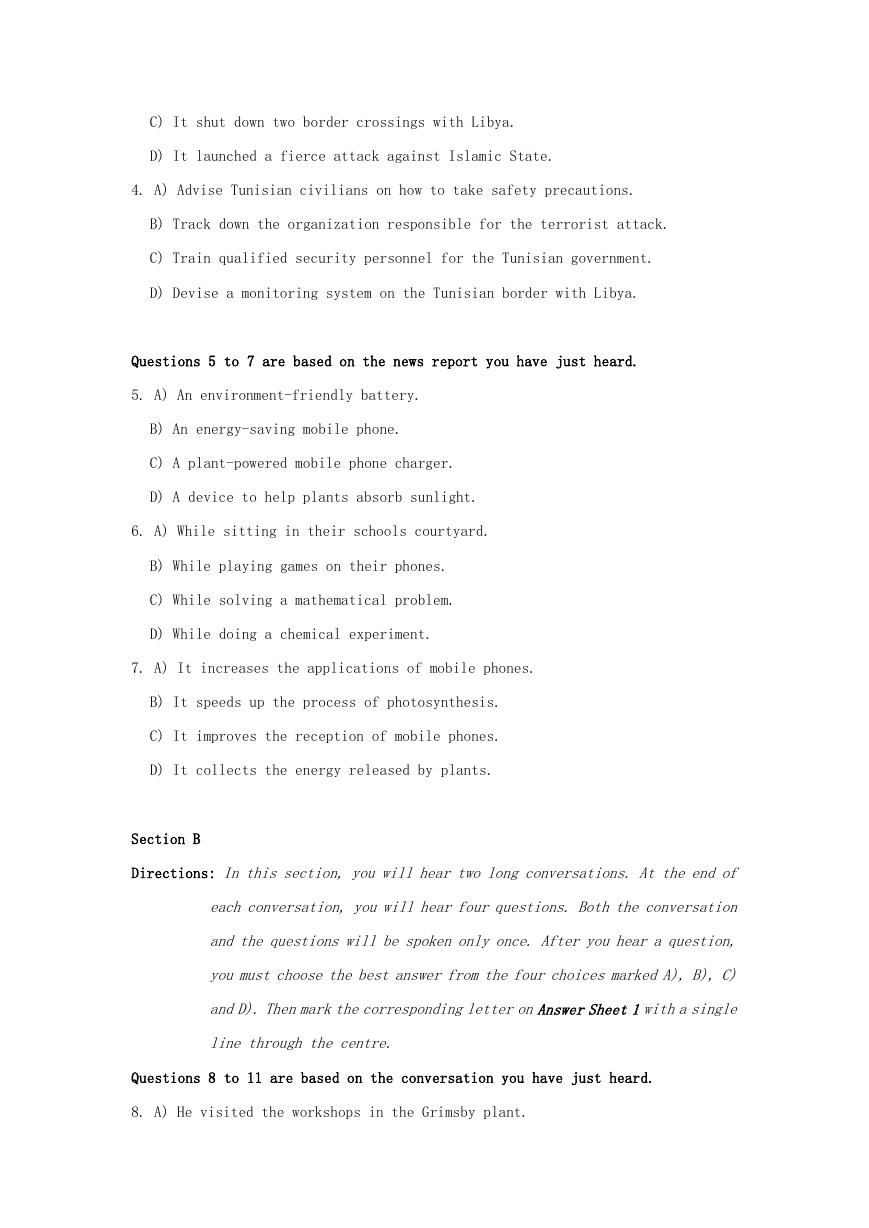
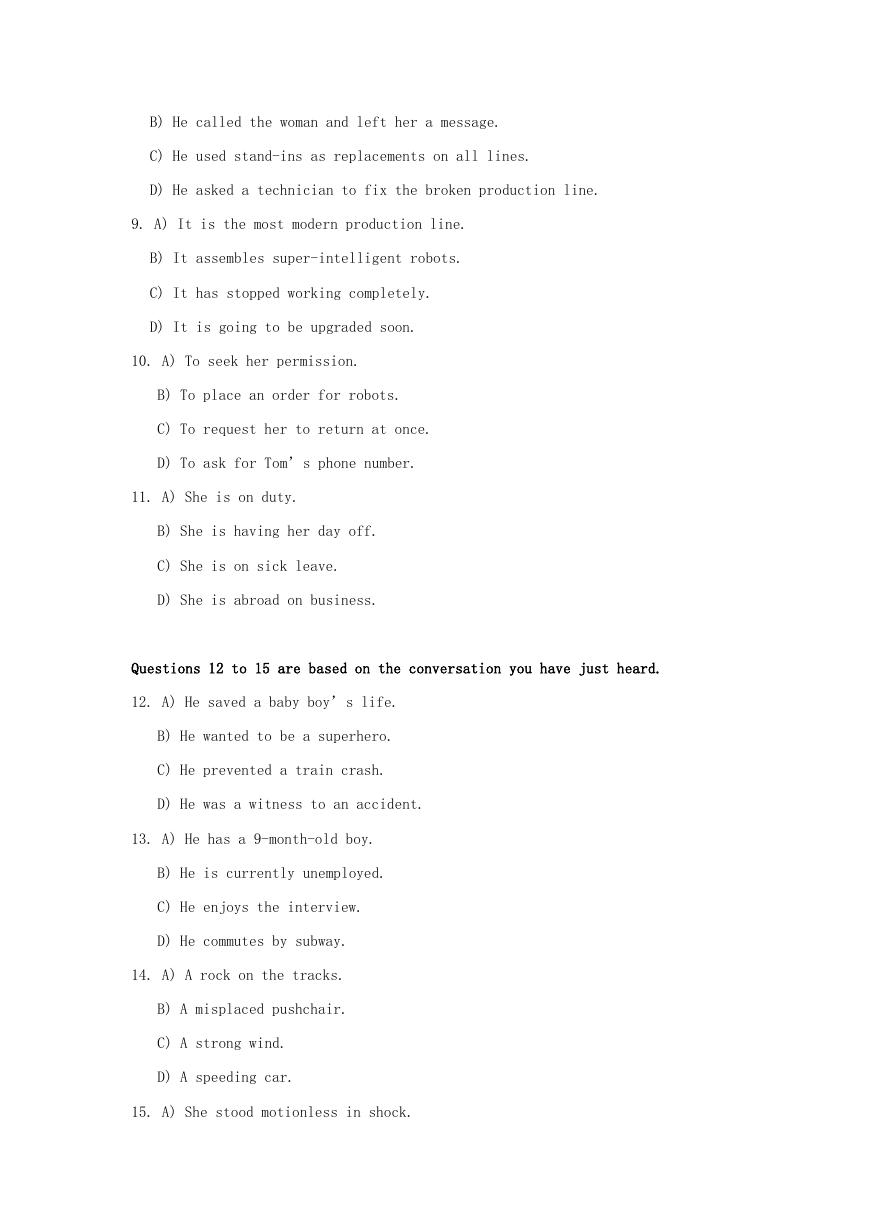
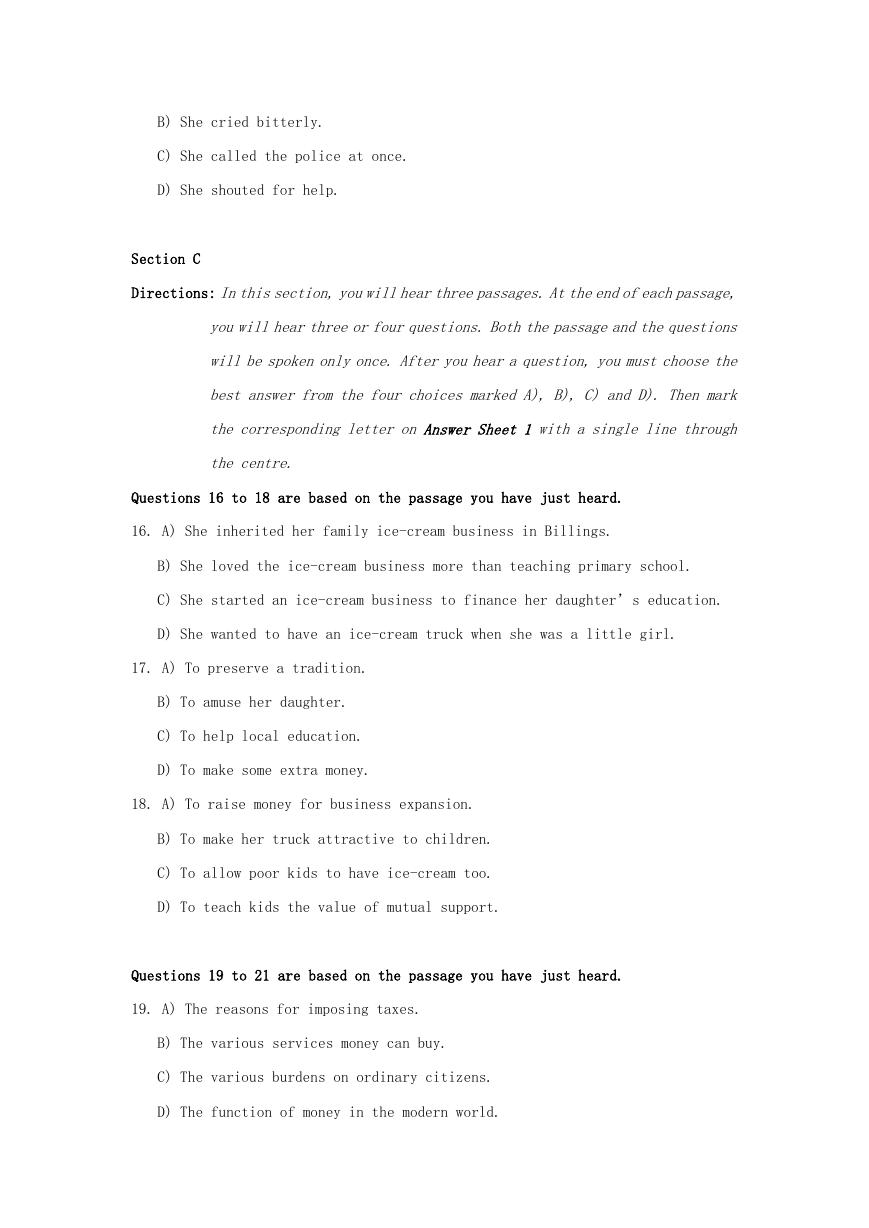
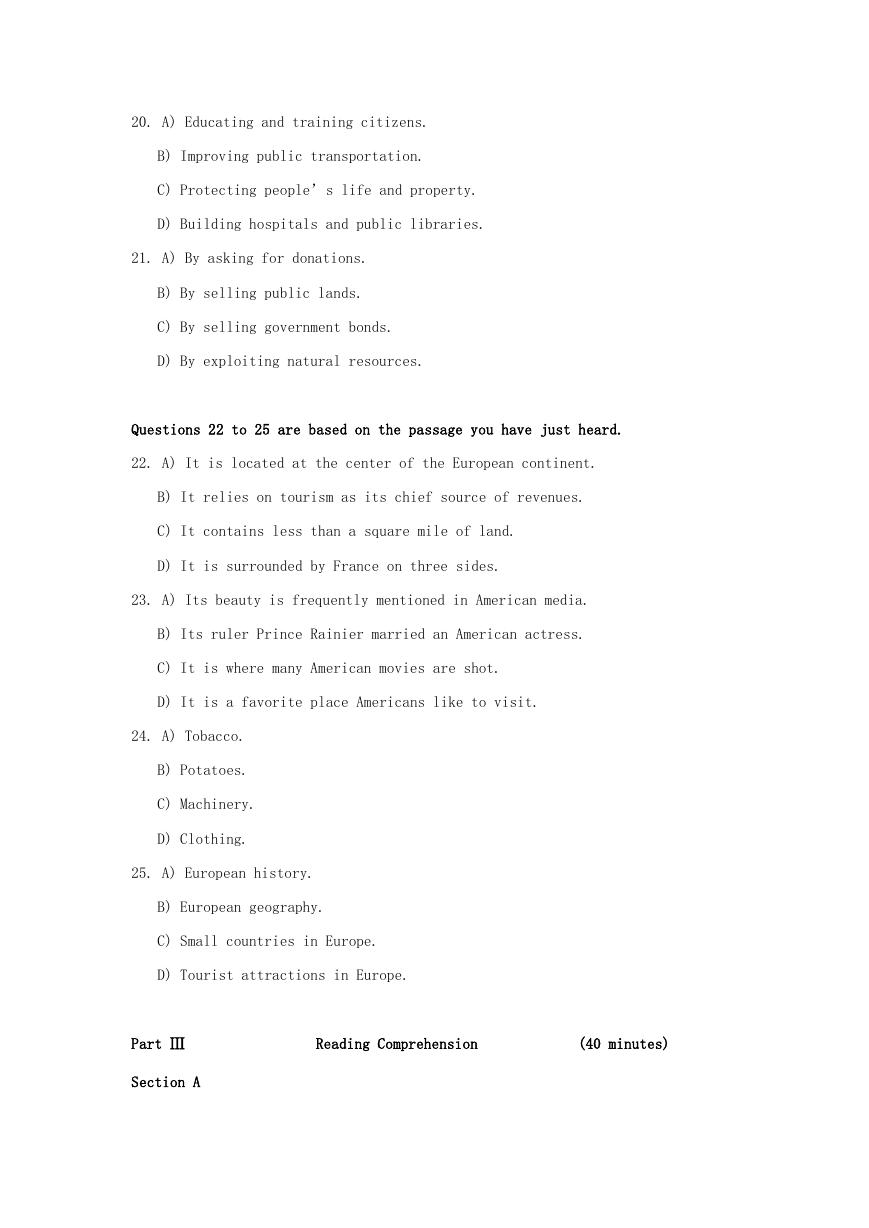
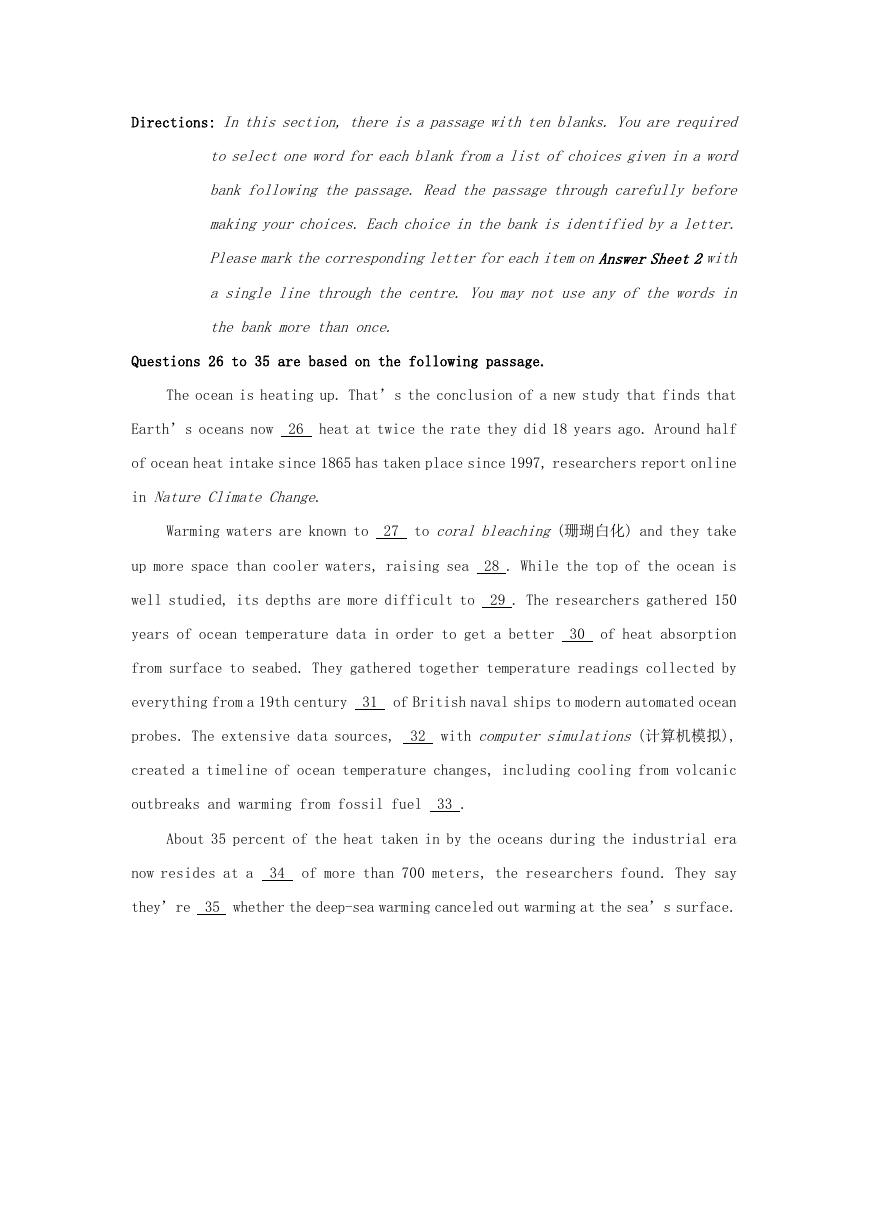

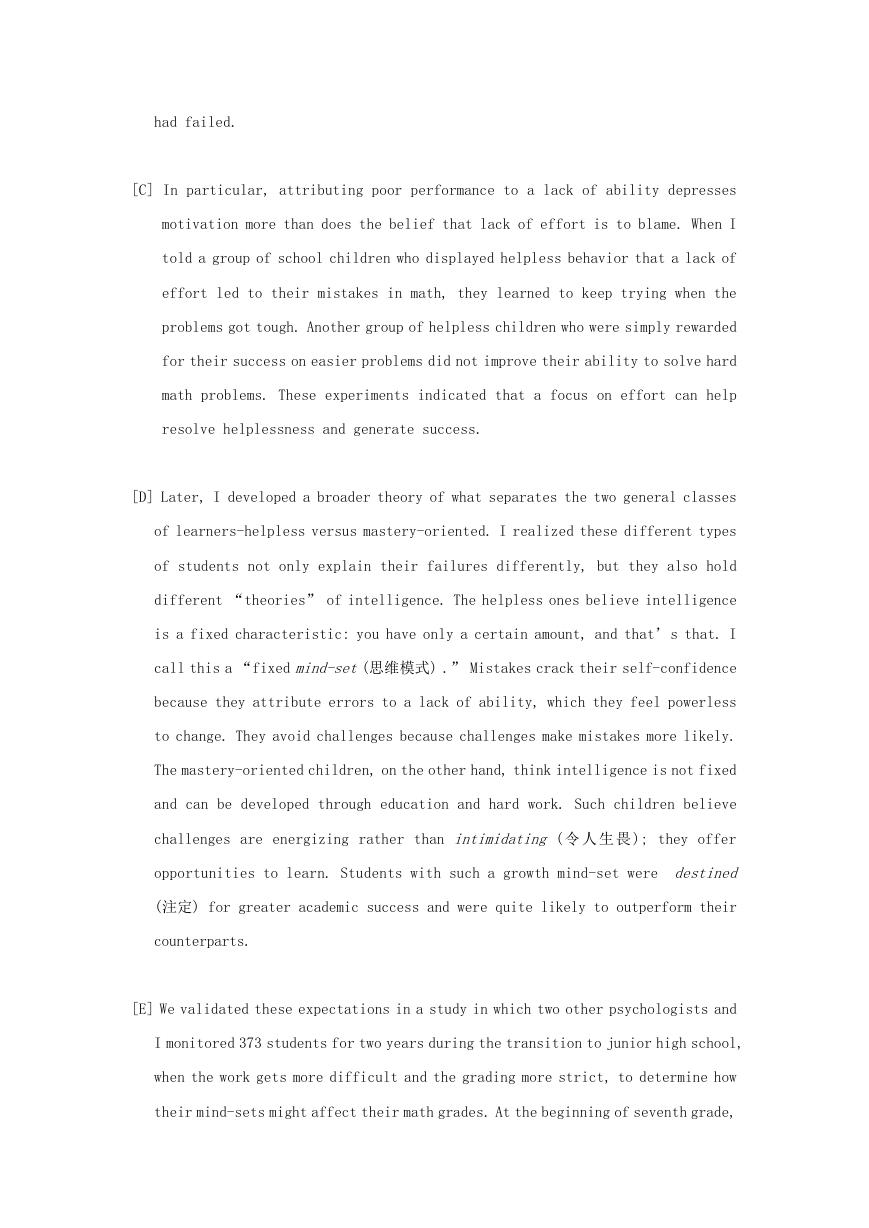








 2023年江西萍乡中考道德与法治真题及答案.doc
2023年江西萍乡中考道德与法治真题及答案.doc 2012年重庆南川中考生物真题及答案.doc
2012年重庆南川中考生物真题及答案.doc 2013年江西师范大学地理学综合及文艺理论基础考研真题.doc
2013年江西师范大学地理学综合及文艺理论基础考研真题.doc 2020年四川甘孜小升初语文真题及答案I卷.doc
2020年四川甘孜小升初语文真题及答案I卷.doc 2020年注册岩土工程师专业基础考试真题及答案.doc
2020年注册岩土工程师专业基础考试真题及答案.doc 2023-2024学年福建省厦门市九年级上学期数学月考试题及答案.doc
2023-2024学年福建省厦门市九年级上学期数学月考试题及答案.doc 2021-2022学年辽宁省沈阳市大东区九年级上学期语文期末试题及答案.doc
2021-2022学年辽宁省沈阳市大东区九年级上学期语文期末试题及答案.doc 2022-2023学年北京东城区初三第一学期物理期末试卷及答案.doc
2022-2023学年北京东城区初三第一学期物理期末试卷及答案.doc 2018上半年江西教师资格初中地理学科知识与教学能力真题及答案.doc
2018上半年江西教师资格初中地理学科知识与教学能力真题及答案.doc 2012年河北国家公务员申论考试真题及答案-省级.doc
2012年河北国家公务员申论考试真题及答案-省级.doc 2020-2021学年江苏省扬州市江都区邵樊片九年级上学期数学第一次质量检测试题及答案.doc
2020-2021学年江苏省扬州市江都区邵樊片九年级上学期数学第一次质量检测试题及答案.doc 2022下半年黑龙江教师资格证中学综合素质真题及答案.doc
2022下半年黑龙江教师资格证中学综合素质真题及答案.doc